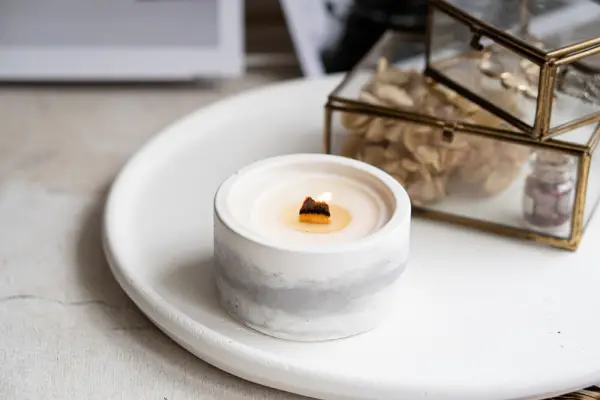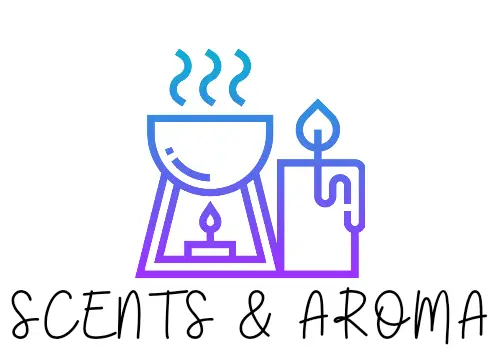While the Romans were said to use papyrus to form a wood-like wick for their candles, this soon changed, and wicks were developed using tallow, hemp, and cotton.
In recent years, however, people have begun experimenting once again with wood wick candles due to their clean-burning, warm crackles, and scent throw abilities.
So, what are wooden candle wicks made from? The short answer is: many types of wood are used a candle wicks! Both soft and hardwoods can be used for wooden wicks. But, typically, balsa wood is the most affordable, common and easiest option when it comes to creating a wooden candle wick.
What type of wood is used in a wooden candle wick?

As stated above, balsa wood makes a great wood wick because it’s relatively cheap and is easy to make into a wick. Other types of wood include oak, birch, cherry, rosewood, maple or a combination.
Which type of wood is best for a wood wick?
When choosing a wood wick for a candle, it’s not so much about the type of wood that matters but the type of wick itself.
Recently I actually did a cool experiment, I tested if you could use a wooden toothpick as a candle wick. If you would like to see the results check out the article.
Anyway..
Based on the amount of wood and type used, wooden wicks can belong to one of the following categories:
- Single-ply wicks
- Spiral wicks
- Whisper wicks
- Booster wicks.
Let’s look at these in more detail:
Single-ply wicks
When thinking of candle wicks, you think of them as small and thin – the same applies to wooden wicks. Many wooden wicks use a thin strip of ply or wood. A single-ply wood wick is often referred to by its width, thickness, and crackle characteristics.
In terms of crackle, this can either be quiet or loud. This is because the wood naturally contains plant matter that burns differently and less consistently when compared to cotton. As a result, single-ply wooden wicks can either crackle loudly or quietly.
Typically, single-ply wood wicks are the thinnest types of wooden wick you’ll find. Generally, they will be 0.02” to 0.02” thick.
As far as width goes, these single-ply wood wicks are usually 0.375” to 0.75” wide. It is also possible to source custom-sized wood wicks.
Spiral wicks
Spiral wood wicks are core-less wooden wicks that are made from a rolled wooden strip and is hollow in the middle. Essentially, these wicks are just thick sheets of wood wrapped around in a spiral shape. Spiral wicks tend to be used in candles when a hotter and brighter flame is needed.
Whisper wicks
These are the same as a single-ply wooden wick, but they don’t crackle. Some people love the crackling sound a wooden wick makes, whereas others prefer a quieter candle like those with a traditional cotton wick.
Booster wicks
As wooden wicks can be a challenge to burn with natural waxes, you’ll often find these accompanying a single-ply wick. A booster wick is almost the same as a single-ply, but an extra wooden strip runs through the wick’s centre. So with a booster wick, there’s more crackle.
Why do we use wooden candle wicks?
Wooden wicks have many pros (as well as a few cons).
First of all, a candle with a wooden wick will be much stronger. The flame will be brighter and easier to light (initially, at least).
If you like the crackles that you get with open wood fires, a wooden wick has the same effect – unless you choose the ‘whisper’ style, in which case, they can be made so that they burn quietly.
Another great thing that many people like about wooden wicks is how they create a horizontal flame due to their shape. If you choose a spiral wood wick, this won’t happen, though, and you’ll get a higher, teardrop-shaped flame.
Even though wooden wicks produce a hotter flame, your candle actually burns more slowly.
Not only that, but these wicks throw the heat wider across the candle, which means the scent throw is much better when your candle is alight. Since the candle will burn more slowly overall, it will last a long time compared to a candle with a cotton wick.
We should mention here, though, that there are a few cons to consider when looking at wooden wicks.
Firstly, it can be a little challenging to relight a wooden wick that has previously been lit. You’ll probably need to hold a lighter to it for at least 20 seconds before it will light after the first time.
Wooden wick candles need some time to settle in before there is enough melted wax at the base.
Secondly, some people don’t like that these produce a hotter flame for safety reasons. They also don’t fare very well outdoors and can blow out easily. And, since they take a while to reignite, this can be annoying. Finally, candles that have a wooden wick need more maintenance than a candle with a cotton wick.
If you would like to see the difference between a Wooden wick and a cotton wick in terms of efficiency, have a look at my guide.
Can you use a wood wick in a soy wax candle?
You’ll see many claims online that wood wicks can’t be used with natural waxes, which is not entirely true. While wooden wicks do fare better with paraffin or parasoy wax, you can still use them with natural waxes like soy if certain parameters are met.
Firstly, soy does burn more slowly than paraffin, which is what makes using wooden wicks with soy wax more difficult. However, with the correct sized wick (width as well as thickness), there is no reason why a wooden wick won’t work in a soy wax candle, especially if you use a booster wick.
Can you use a wood wick in a beeswax candle?
As we’ve said above, with regards to soy wax, you can use wooden wicks with natural wax – including beeswax. As above, you need to ensure the wick is the correct size in terms of width and thickness, and you’re good to go.
For natural waxes like soy and beeswax, a 0.4” booster wick is a good choice.
Final thoughts and conclusion
To sum up, there are many differences between wooden wicks and their more traditional cotton counterparts. Unlike cotton wicks, wooden ones are much more varied in style and materials.
There are lots of woods used to make wooden candle wicks with balsa wood being the most popular thanks to its easy use.
As we’ve discussed, it’s not so much about the type of wood used with wooden wicks, but more about the style of wick: its thickness and width.
Wooden wicks have many pros, including their lovely crackle, magnificent scent through and slower burn. But, as always, there are some cons – which might be why they haven’t taken over the candle-making world completely.
Wooden wicks are much more difficult to relight compared to cotton wicks, and it could take up to three tries to get it going. With this, then, you’ll need to use a stick lighter as a matchstick just won’t cut it.
Despite the few cons, wooden wicks are becoming more popular due to their ambience and sustainability, among other things we’ve already mentioned. So it’s quite likely that wooden wicks will start becoming more and more mainstream as people look towards new and sustainable options for their candles.
- Can You Put Perfume In A Humidifier? (Read First) - September 17, 2022
- Can You Put Essential Oil In A Steam Mop? (Safety Advice) - September 17, 2022
- How To Make Lavender Oil At Home ( Candles And Diffusers) - September 9, 2022
